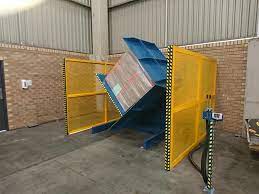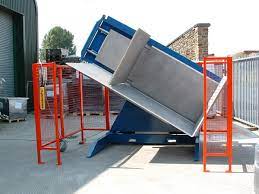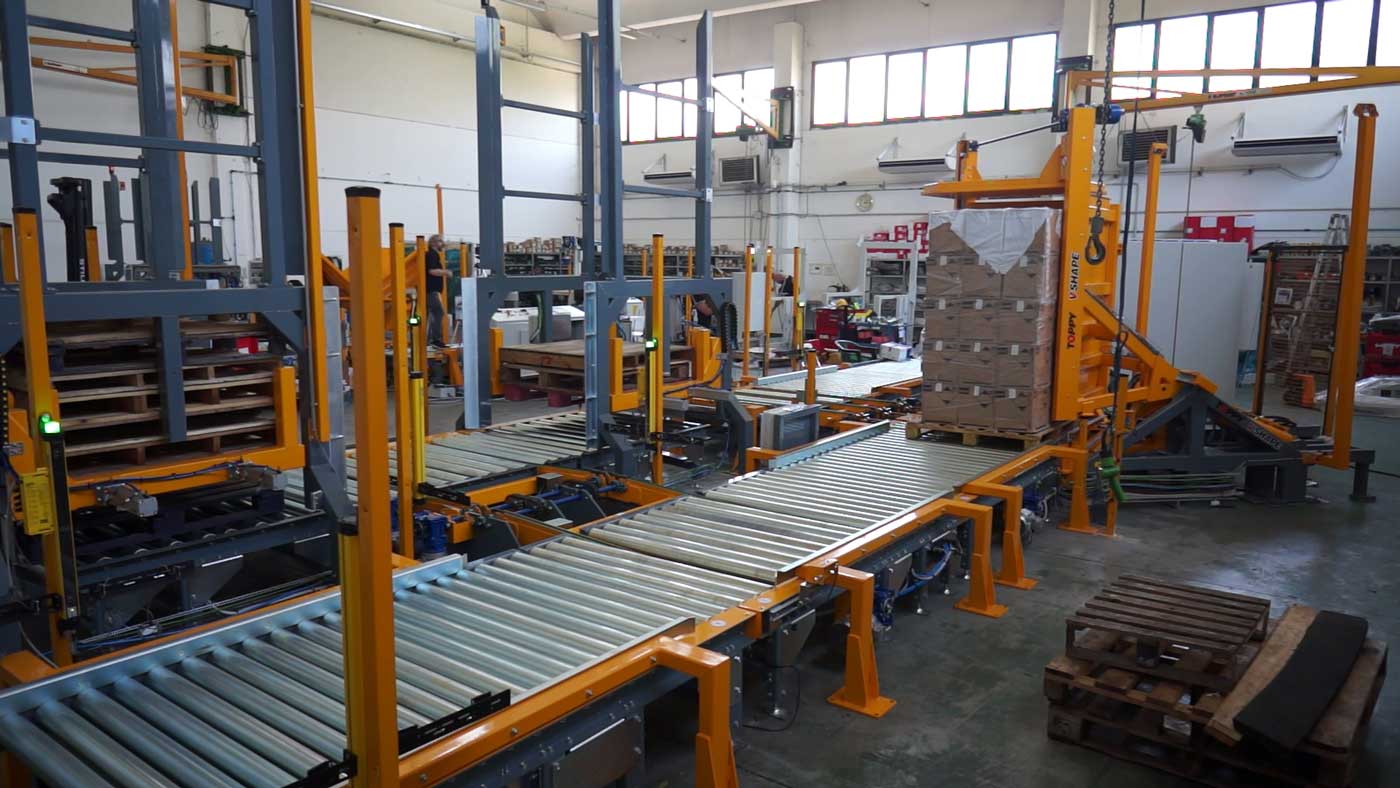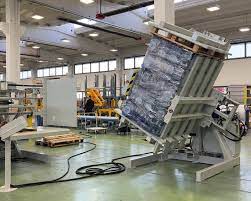Pallet Inverter: How Can Hospitals Swap Sterile Supply Pallets Safely?
Hospitals face a constant challenge. They need to move sterile supplies from the outside world into hyper-clean environments like operating rooms and laboratories. These supplies often arrive on standard wooden pallets, which are carriers of dust, moisture, and microbes. Manually transferring heavy boxes from a "dirty" pallet to a sanitized one is slow, physically demanding for staff, and creates a significant risk of product damage or contamination. A single mistake can compromise patient safety and lead to severe consequences.
A pallet inverter is a specialized machine that offers a safe and efficient solution. It allows hospitals to swap sterile supply pallets by securely clamping the entire load, rotating it, and enabling the exchange of the original pallet for a sterilized, in-house one. This automated process happens without any manual lifting of individual items, protecting both the supplies from contamination and the staff from injury.

This simple-sounding process is a game-changer for medical logistics. It removes a major contamination risk at the point of entry. It also speeds up the entire receiving process, ensuring that critical supplies get where they need to be, faster. As someone who has spent decades designing industrial machinery, I know that the best solutions are often those that solve a complex problem with robust, reliable mechanics. Let's explore how this technology specifically addresses the unique needs of a hospital environment.
Why is a standard pallet exchange not enough for sterile environments?
You might be thinking, "Can't we just have staff move boxes from one pallet to another?" This is a common first thought, but it's an approach filled with hidden risks and costs, especially in a place where cleanliness is a matter of life and death. The manual process is slow and introduces too many variables. Each time a person handles a box, there is a chance of dropping it, damaging the contents, or introducing contaminants from their gloves or clothing. This method relies heavily on human procedure, and humans, even with the best training, can make mistakes.
Imagine the pressure on a logistics team rushing to supply an operating room. They have to move dozens of boxes quickly and perfectly. The physical strain leads to fatigue, which increases the likelihood of errors and workplace injuries. These risks are simply not acceptable in a healthcare setting. A standard manual exchange fails to provide the level of control, repeatability, and safety required for sterile environments.
A standard pallet exchange is insufficient for sterile environments because it fails to eliminate the primary risks of contamination and human error. Manual handling introduces microbes, dust, and potential for damage with every touch. It is also slow and ergonomically unsafe for staff. A controlled, automated system is necessary to ensure a certifiably clean and secure transfer.

A Deeper Look at the Risks
When we break down the manual transfer process, the issues become even clearer. It's not just about moving boxes; it's about maintaining a sterile chain of custody. Any break in this chain can have serious repercussions. The core problem is the lack of a controlled system.
Manual Handling vs. Automated Inversion
Let’s compare the different methods. We have the standard manual transfer, a pallet pusher (which shoves the load from one pallet to another), and a full pallet inverter. From my experience in factory automation, moving from manual to automated processes always brings huge gains in quality and safety.
| Feature | Manual Transfer | Pallet Pusher | Pallet Inverter |
|---|---|---|---|
| Contamination Risk | High (direct handling, airborne dust) | Medium (sliding can create dust) | Low (load is clamped, no sliding) |
| Product Damage Risk | High (dropping, crushing) | Medium (unstable loads can shift) | Low (secure clamping pressure) |
| Worker Safety | Low (risk of back injuries) | High | High (fully automated) |
| Speed | Very Slow (box by box) | Fast | Very Fast (entire load at once) |
| Suitability for Sterile Use | Not Recommended | Better, but not ideal | Ideal |
The Contamination Pathway
Contamination doesn't just come from dirty hands. Wooden pallets are porous. They can absorb moisture, which fosters the growth of mold and bacteria. They shed splinters and dust. When a pallet is brought into a receiving area, these contaminants become airborne. A pallet pusher, while better than manual handling, can still cause issues by scraping the bottom layer of boxes across a surface, potentially tearing packaging and creating friction-generated particles. The pallet inverter solves this by lifting the entire load cleanly away from the pallet, creating a clear air gap and preventing any contact during the swap. This is the only method that truly isolates the product from its original, non-sterile carrier.
What are the key features of a pallet inverter designed for hospital use?
When you are specifying a machine for a hospital, the requirements are much stricter than for a general warehouse. It's not just about function; it's about hygiene, safety, and precision. A standard pallet inverter from a factory floor might not be suitable. The design must be adapted to meet the stringent demands of a clean environment. Every component, from the surface material to the control system, must be chosen with sanitation and delicate handling in mind.
Think about the environment it will operate in. It needs to be washed down and sanitized regularly. The products it handles are often fragile and extremely valuable. There can be no margin for error. The machine must perform its task perfectly every time, protecting both the product and the operator. This requires a different level of engineering and a focus on details that might be overlooked in other industries.
A pallet inverter for hospital use must have features specifically for sterile environments. Key among these are stainless steel construction for easy cleaning and corrosion resistance, adjustable and gentle clamping pressure to protect delicate medical supplies, and comprehensive safety systems like light curtains and physical guarding to protect personnel.

Material and Construction
The first and most critical feature is the material. For any equipment in a clean or wash-down environment, stainless steel is the standard. I've seen firsthand in food processing and pharmaceutical plants how crucial this is.
- Stainless Steel Body: A full stainless steel construction (often 304 grade) is non-porous and resists rust and corrosion from harsh cleaning chemicals. This prevents the machine itself from becoming a source of contamination.
- Sealed Welds: All welds must be smooth and continuous, leaving no crevices where bacteria can hide and multiply. This is a small detail that makes a huge difference in cleanability.
Precision and Control
Handling medical supplies is not like handling bags of cement. The clamping mechanism must be powerful enough to hold the load securely but gentle enough not to crush a single box.
- Adjustable Clamping Pressure: The hydraulic or electric system must allow users to set the clamping pressure based on the load. A control panel with presets for different product types (e.g., "IV bags," "testing kits") can make this process foolproof.
- Soft-Touch Surfaces: The clamping plates that touch the load are often coated with rubber or a soft polymer to prevent marking or damaging the packaging.
Safety and Compliance
In a hospital, safety is paramount. The machine must be designed to eliminate any risk to the operator.
| Safety Feature | Purpose | Why It's Critical in a Hospital |
|---|---|---|
| Safety Light Curtains | Creates an invisible barrier. If broken, the machine stops instantly. | Prevents an operator from reaching into the machine during its cycle. |
| Physical Guarding | A fence or enclosure around the operational area. | Provides a permanent physical barrier to entry while the machine is active. |
| Emergency Stops | Large, accessible buttons that immediately halt all motion. | Allows for immediate shutdown in any unforeseen situation. |
| Controlled Access | Requiring a key or passcode to operate. | Ensures only trained personnel can use the equipment, preventing accidents. |
These features combined create a machine that is not only effective but also integrates seamlessly and safely into the highly regulated world of hospital logistics.
How does a pallet inverter improve workflow and safety in medical logistics?
Implementing a pallet inverter does more than just solve the contamination problem. It fundamentally changes the workflow at the hospital's receiving dock for the better. The old process is a bottleneck. It’s a slow, manual, and unpredictable step that holds up the entire internal supply chain. By automating this crucial transfer point, you create a faster, more reliable, and safer flow of goods.
Think of it as transforming a bumpy country road into a modern highway. Before, every delivery was a slow, careful journey with many chances for things to go wrong. Now, you have a streamlined process where goods flow through a dedicated, automated checkpoint. This efficiency boost ripples through the entire hospital. Supplies reach sterile storage and operating rooms faster, and logistics staff are freed up from dangerous manual labor to focus on other critical tasks.
A pallet inverter improves workflow by creating a fast and predictable pallet exchange process, eliminating receiving dock bottlenecks. It enhances safety by removing the need for manual lifting, drastically reducing the risk of musculoskeletal injuries for staff and ensuring a documented, repeatable procedure for handling sterile goods.

Redefining the Receiving Process
Let's walk through the "before" and "after" workflow. This is where the true impact of the technology becomes clear. I've helped many factories redesign their processes around a key piece of automation, and the results are always transformative.
Before: The Manual Workflow
- Truck arrives. Forklift unloads a wooden pallet of supplies.
- Pallet is placed in a staging area.
- Two staff members begin manually unstacking boxes.
- They carry the boxes a short distance to a clean, sanitized plastic pallet.
- They restack the boxes onto the new pallet.
- This process is repeated until the pallet is clear. Time taken: 15-20 minutes. Risk: High.
After: The Automated Workflow
- Truck arrives. Forklift unloads a wooden pallet of supplies.
- The forklift places the entire pallet directly into the pallet inverter.
- An operator pushes a button.
- The machine clamps, inverts, and allows the wooden pallet to be removed. A clean pallet is inserted. The machine rotates back.
- The forklift removes the load, now on a clean pallet, ready for internal transport.
- Total time: 1-2 minutes. Risk: Minimal.
Quantifiable Improvements in Safety and Efficiency
The new workflow isn't just faster; it's measurably safer and more efficient. For a manager who needs to justify costs and show results, these numbers are crucial.
- Labor Reduction: The task now requires one operator instead of two. The second person can be reassigned to value-added tasks. This is a direct saving on labor costs.
- Injury Prevention: Manual handling of heavy, repetitive loads is a leading cause of musculoskeletal disorders (MSDs), a major source of worker compensation claims. Automating this task virtually eliminates that risk. The cost of one serious back injury can often exceed the cost of the machine itself.
- Increased Throughput: A process that took 20 minutes now takes 2. A hospital can process ten times the volume of goods through the same receiving door in the same amount of time. This is critical for large hospitals or during emergencies when supply volumes surge.
- Process Standardization: The automated process is the same every single time. This is key for compliance and quality control. It creates a documented, auditable step in the sterile supply chain, which is invaluable for certifications and regulatory oversight.
What are the ROI considerations for investing in a pallet inverter in a hospital?
As a factory owner myself, I know that every equipment purchase comes down to the numbers. An investment must pay for itself. For a hospital administrator or a pragmatic CEO like Javier, a pallet inverter is not just a piece of safety equipment; it's a financial asset. The return on investment (ROI) isn't calculated just on one factor, but on a combination of direct cost savings, risk avoidance, and efficiency gains.
You have to look beyond the initial price tag. What is the cost of not having this machine? You must consider the ongoing expenses of manual labor, the potential cost of a workplace injury claim, the financial impact of damaged goods, and the immense, unquantifiable cost of a contamination event that could harm a patient. When you add all these factors together, the investment in automation often looks not just smart, but essential.
The ROI for a pallet inverter in a hospital is calculated by combining direct labor savings, reduced costs from preventing worker injuries and product damage, and the priceless value of avoiding contamination-related incidents. These combined savings and risk mitigation benefits typically result in a payback period of 12-24 months.

Breaking Down the Financial Case
To make a decision, a leader needs to see a clear financial breakdown. Let's build a simplified ROI model. This is the kind of analysis I perform before buying any new machine for my own factory.
1. Direct Cost Savings (Hard ROI)
This part is the easiest to calculate.
-
Labor Savings:
- Assume 2 workers take 15 mins (.25 hours) per pallet.
- Assume 1 operator with an inverter takes 2 mins (.033 hours) per pallet.
- Time saved per pallet: .217 hours.
- If a hospital processes 20 pallets a day, that's 4.34 hours saved daily.
- At a labor rate of $25/hour (including benefits), that's a saving of over $100 per day, or more than $26,000 per year.
-
Reduced Product Damage:
- If manual handling results in a 0.5% damage rate on goods valued at $5,000 per pallet, that's $25 of damage per pallet.
- For 20 pallets a day, that's $500 in daily damage, or $130,000 annually.
- If an inverter reduces this damage by 90%, the saving is $117,000 per year.
2. Risk Mitigation (Soft ROI)
This is harder to quantify but is often the most significant factor.
| Risk Category | Estimated Cost of a Single Incident | Likelihood Reduction with Inverter |
|---|---|---|
| Worker Injury (MSD) | $40,000 - $80,000 (avg. claim) | Drastically Reduces Likelihood |
| Contamination Event | $100,000 - $1,000,000+ (lawsuits, fines) | Creates a Controlled, Auditable Barrier |
| Supply Chain Disruption | Varies (cost of delayed surgeries, etc.) | Increases Throughput and Reliability |
Even preventing one single moderate injury or contamination scare can pay for the machine several times over. For a hospital board or an owner, this reduction in liability is a powerful motivator. The pallet inverter acts as an insurance policy that also pays you back in efficiency.
My Insights
Throughout my career, from my first days on the factory floor to running my own company, SHJLPACK, I've learned one crucial lesson: the best solutions control variables. We've talked about hospitals today, a setting where control over contamination is a matter of life and death. But the core principles apply everywhere.
When I work with clients in the steel industry, like a forward-thinking owner such as Javier Morales, the challenges are different on the surface but fundamentally the same. He isn't worried about microbes; he's worried about moisture causing rust on a high-value steel coil. He isn't worried about sterile packaging; he's worried about protecting a finished product from scratches or damage during transport. In both cases, the goal is to protect the integrity of the product by controlling the process.
A pallet inverter is a tool of control. It takes a manual, unpredictable, and risky process—transferring a load—and makes it automated, repeatable, and safe. It eliminates human error, protects the product, and keeps people safe. Whether you are moving sterile kits into an operating room or finished steel wire onto a warehouse pallet, you are solving the same problem: how to move goods from one platform to another without compromising their value.
For any leader focused on operational excellence, seeing a solution like this in one industry should spark ideas for their own. It’s about recognizing a fundamental weakness in your process and finding the right technology to build a stronger, more reliable system. That is how successful businesses grow and thrive.
Conclusion
A pallet inverter is an essential tool for hospitals, providing a safe, fast, and reliable method to swap sterile supplies from external to in-house pallets, protecting both products and personnel.


